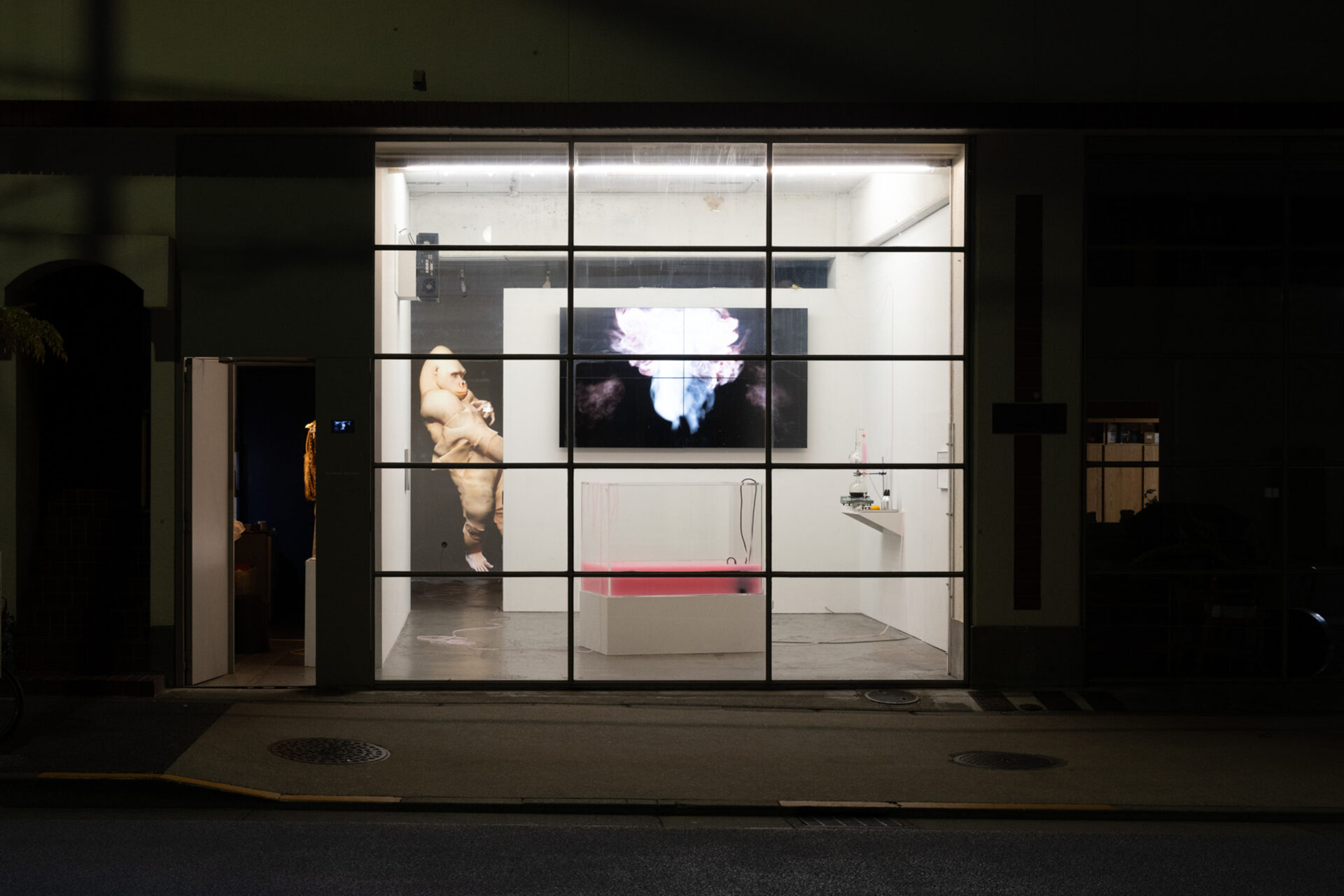Critic/Curator. Specializes in art studies. His interdisciplinary activities center on the critique and curation of fine art, photography, film, and music in an exploration of the possibilities of art from modernism onward. He has curated programs including “DE/construct: Updating Modernism- three programs about Yuzuru Agi” (NADiff modern & SuperDeluxe, 2014), “Trans/ speed, Dub/ paint – Tomoyuki Higuchi” (art trace gallery, 2015), “Trans / Real: The Potential of Intangible Art” (Gallery αM, 2016-17). Curator from 1991 to 2021 at The Museum of Modern Art, Saitama, where he organized/co-organized exhibitions including “1970 Matter and Perception: Mono-ha and the Search for Fundamentals” (1995), “Donald Judd 1960–1991” (1999), “Plastic Age | Art& Design” (2000), “100th Birth Anniversary, Q Ei” (2011), “DECODE / Events & Materials: The Work of Art in the Age of Post-Industrial Society” (2019).
Photo: kugeyasuhide
Installation view “Medium and Dimension: Apparition” AOYAMA|MEGURO, 2023 photo : Koichi Nishiyama
Un-medium and over-dimension: Transubstantiation
“That night, technology was under the illusion it was human.
The human was under the illusion it was technology.”
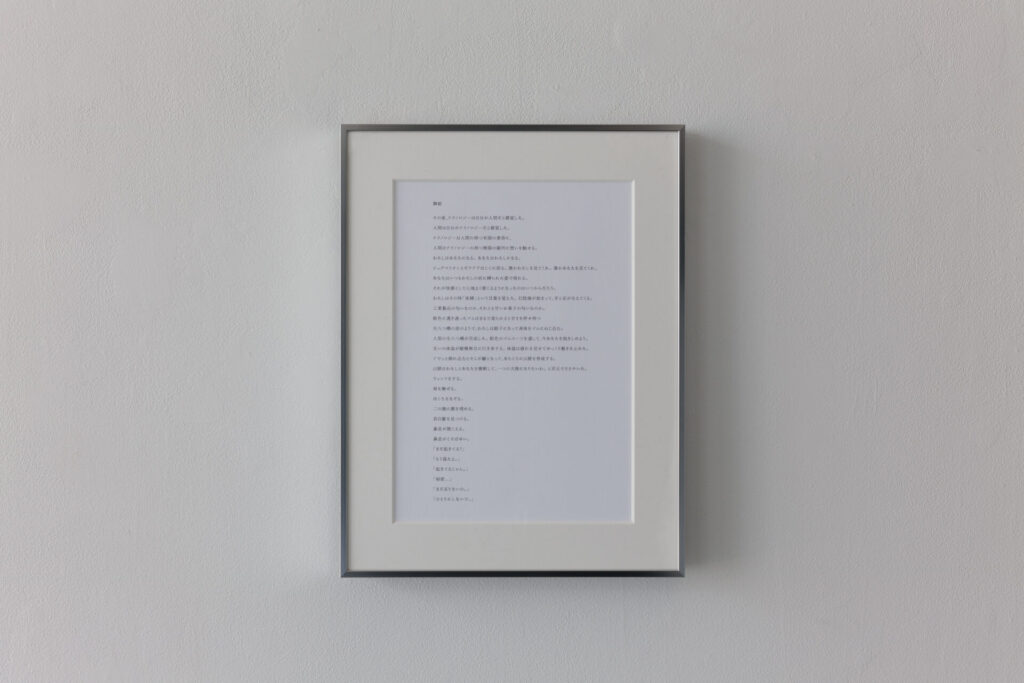
Shota Yamauchi “The Dancing Princess” (detail, 2021) photo: Koichi Nishiyama
“Medium and Dimension: Apparition” consists of Shota Yamauchi’s artworks “The Dancing Princess” and “Apparition.” The above cites the two opening lines of the poem in “The Dancing Princess,” a piece combining video and poetry.
This exhibition was curated by Takuya Nakano in 2023, 100 years after Marcel Duchamp abandoned the production of “The Bride Stripped Bare by Her Bachelors, Even” (a.k.a. “The Large Glass”; 1915–1923). The view of the exhibition from outside the large glass window of Aoyama Meguro brimmed with a charm that was difficult to resist even for myself, someone who has deliberately avoided engaging with Duchamp.
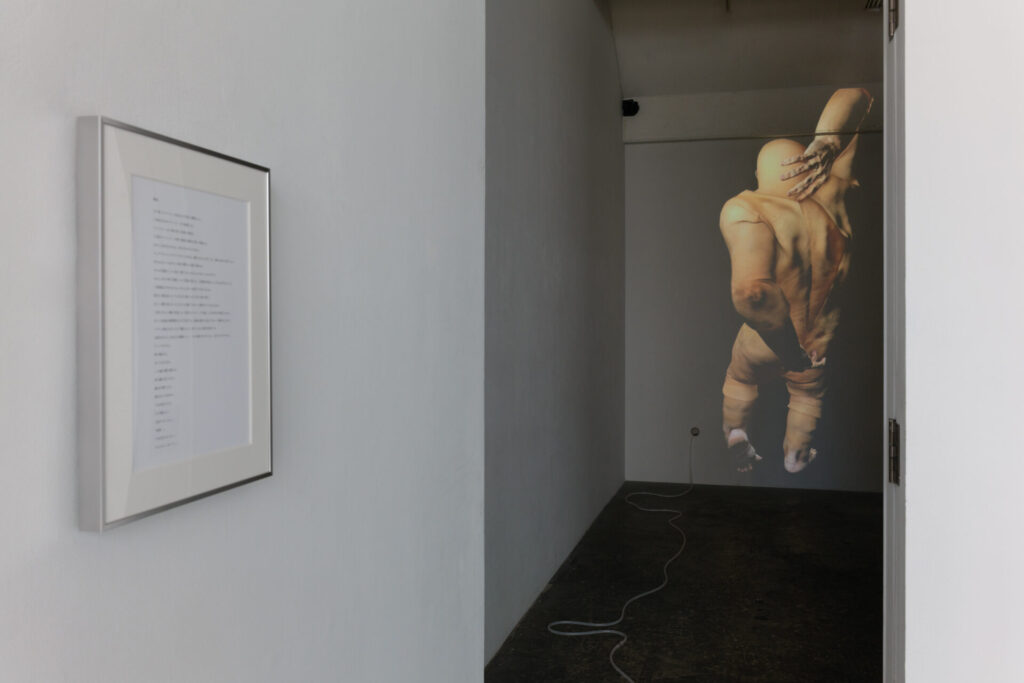
Shota Yamauchi “The Dancing Princess,” 2021 photo: Koichi Nishiyama
That charm is rooted in “apparition,” a concept that appears both in the exhibition title and in the name of one of the artworks. Nakao holds that this word, which captures the essence of Duchamp’s work, also makes for an important perspective in the act of creation in contemporary art. Nakao’s “Apparition” takes over from the point where Duchamp left his piece, illuminating the curatorial aspect latent in “The Large Glass”—a work that can be seen as a collection of Duchamp’s art in exhibition form. Meanwhile, Yamauchi’s “Apparition” draws out aspects of Nakao’s curation that are latent in the work, returning “The Large Glass” into the form of an artwork. The view of the “Apparition” exhibition from outside the glass window resembles “The Large Glass.”
Nakao and Yamauchi work together as unwitting accomplices to reveal the multilayered structure of artwork and curation that underpins “The Large Glass,” uncovering the conflict between the work’s two “desires”—the desire for completion as a piece of art and the desire for transformation into an exhibition—matured over a period of 100 years. This clash of desires drives the reception of Yamauchi’s work.
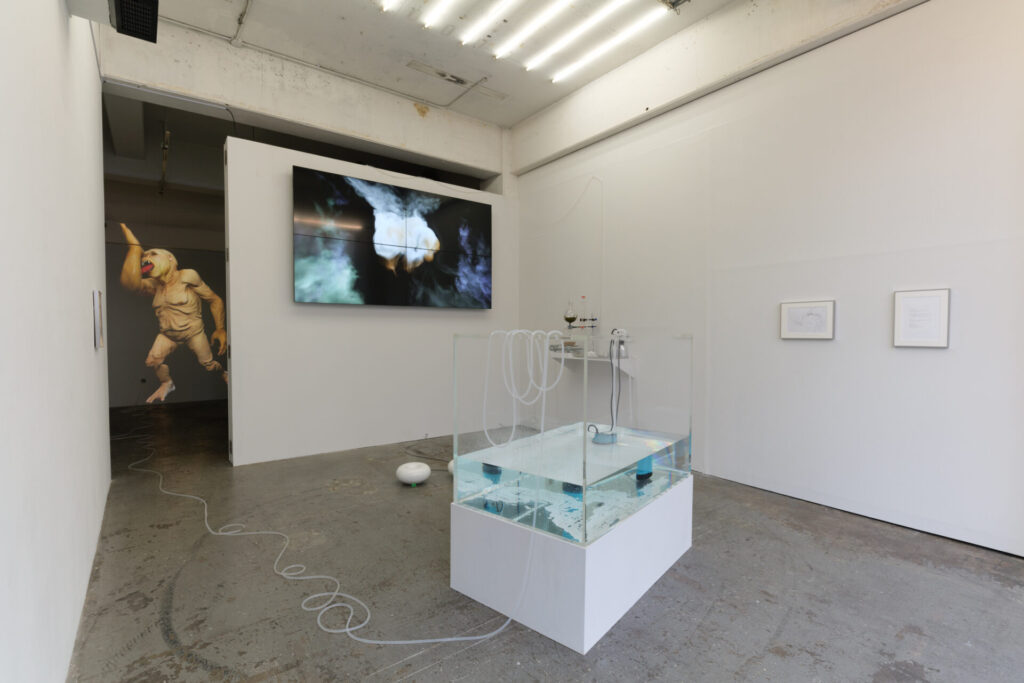
Installation view “Medium and Dimension: Apparition” AOYAMA|MEGURO, 2023 photo : Koichi Nishiyama
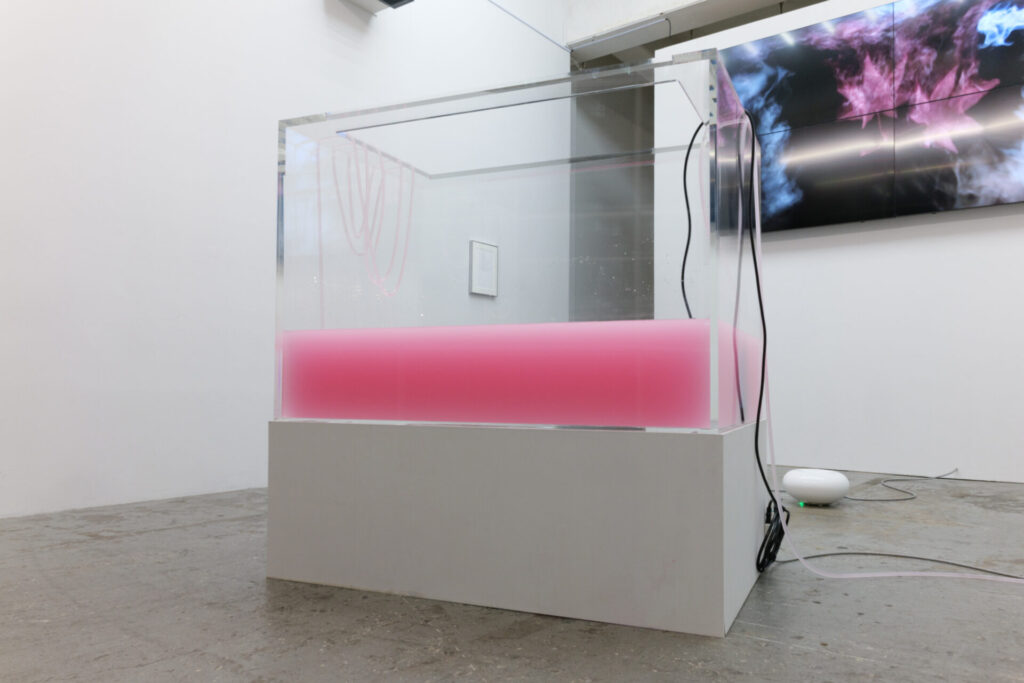
Installation view “Medium and Dimension: Apparition” AOYAMA|MEGURO, 2023 photo : Koichi Nishiyama
My idea of “un-medium” (see “Sound of the Real 3” in the catalog for “Railroad Siding 2015”) was developed in reference to “immedium,” a concept expounded by Akira Mizuta Lippit in an article written for the exhibition catalog of “Reading Cinema, Finding Words: Art after Marcel Broodthaers” (The National Museum of Modern Art, Kyoto, 2013). In plain terms, “un-medium” indicates the “budding state” of a medium that precedes its development into a specific one. The cyclical and composite structures in Yamauchi’s work, including a water tank, distillation, humidification, footage of smoke, repeated images of the shedding of skin, and performance, are suffused with a non-substantial state of “un-medium.”
This pervasive “un-medium” casts the audience into the work. Particles of “smelly” water released by distillation and humidification are absorbed into spectators’ bodies, and “smell” is sprayed on them during the performance. Unable to be grasped by sight alone, the piece defies objective viewing, sweeping the onlooker inside its cyclical structure. Yamauchi’s way of merging technology (a machine/system) and the body (love/eroticism) appeals to an uncontrollable part of our senses and encourages the inter-permeation of technology-symbolizing imagery (as signals and resolution) and water (as circulation and a molecular structure), which is symbolic of life.
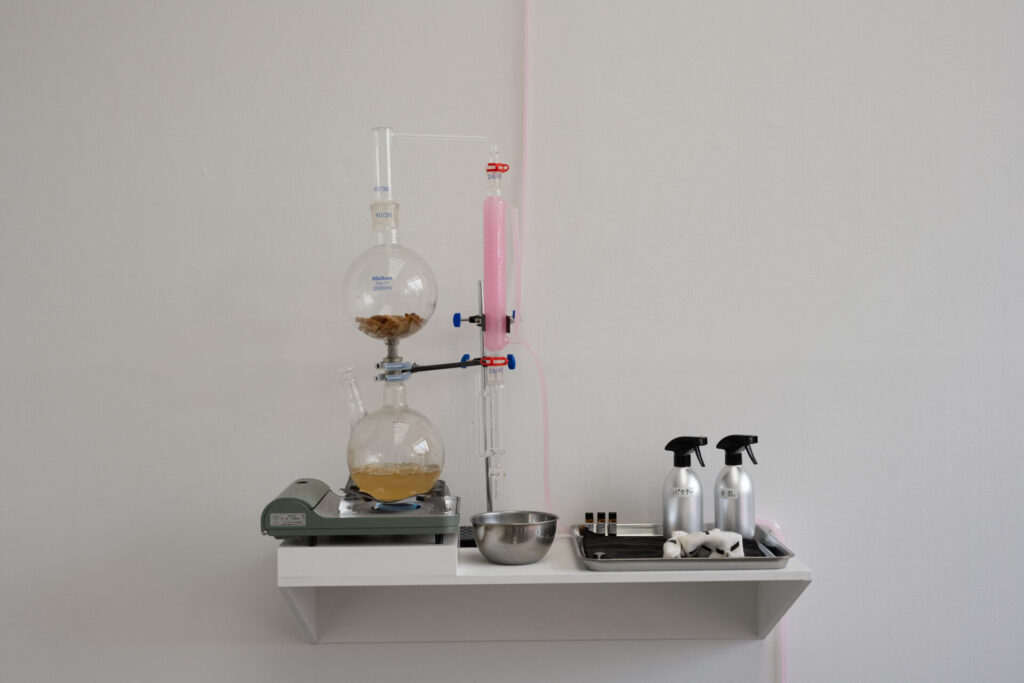
Shota Yamauchi “Apparition”(detail), 2023 photo: Koichi Nishiyama
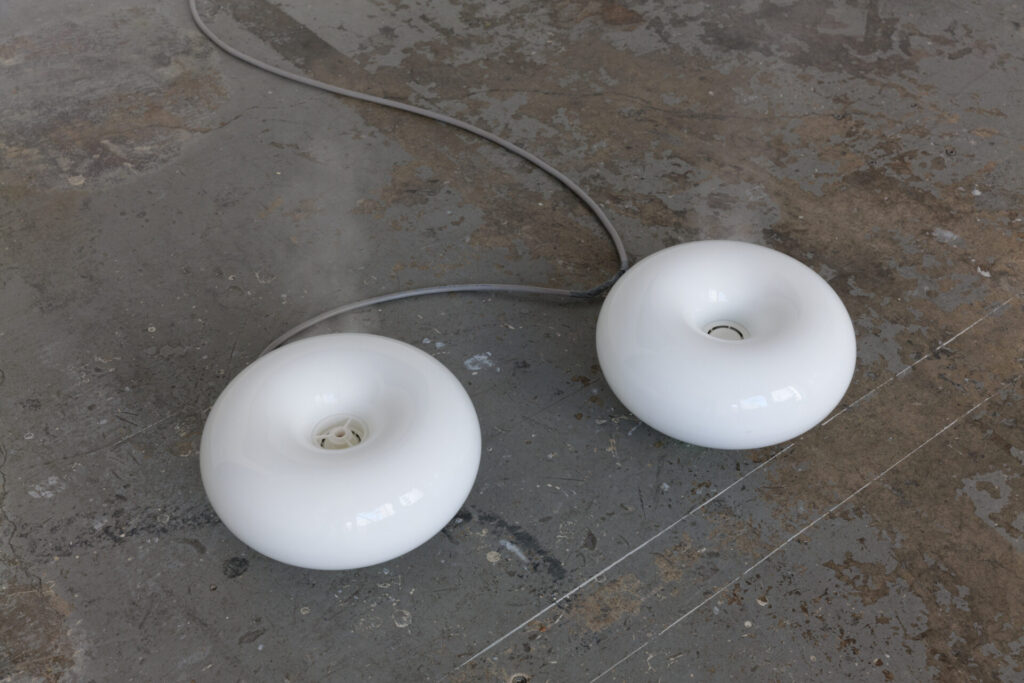
Shota Yamauchi “Apparition”(detail), 2023 photo: Koichi Nishiyama
The film in “The Dancing Princess” depicts a gorilla-like creature shedding its skin over and over. Tubes threaded through holes in the wall onto which this footage is projected connect the water tank and distillation device of “Apparition” to each other, allowing water to circulate. Does this make the gorilla a metaphor for ice, with the shed skin representing meltwater from its surface? The ice-gorilla never melts down completely because the tube keeps feeding new water into the footage, generating new ice. The computer-generated smoke in “Apparition” evokes vaporized water particles, demonstrating the close relationship between distillation and humidification.
“Over-dimension” is a concept I propose here for the first time. According to Nakao, in Duchamp’s “The Large Glass,” “existence in a higher dimensional world, beyond the three dimensions of reality, ‘appears’ on the precipice of the three-dimensional world.” “Over-dimension” is derived from this reference to a “higher dimensional world.” Recognizing the existence of Duchamp’s super-four-dimensional space in our three dimensions takes time, and Yamauchi’s work accomplishes this with time-sensitive elements such as distillation, humidification, video, and performance, through which transitory time transforms materials and bodies into phenomena.
Works that involve time do not allow themselves to be grasped in a static manner, instead forcing the viewer to perceive them dynamically. However, viewing the gallery space from the outside, through the large glass window that is the hallmark of Aoyama Meguro, provides a singular visual experience in which “un-medium” and “over-dimension” are compressed into a single image. When looking into the gallery from the outside, no sounds can be heard or smells perceived. The space behind the glass is compressed, and like in “The Large Glass,” artwork and viewer become one; a visual integration is achieved.
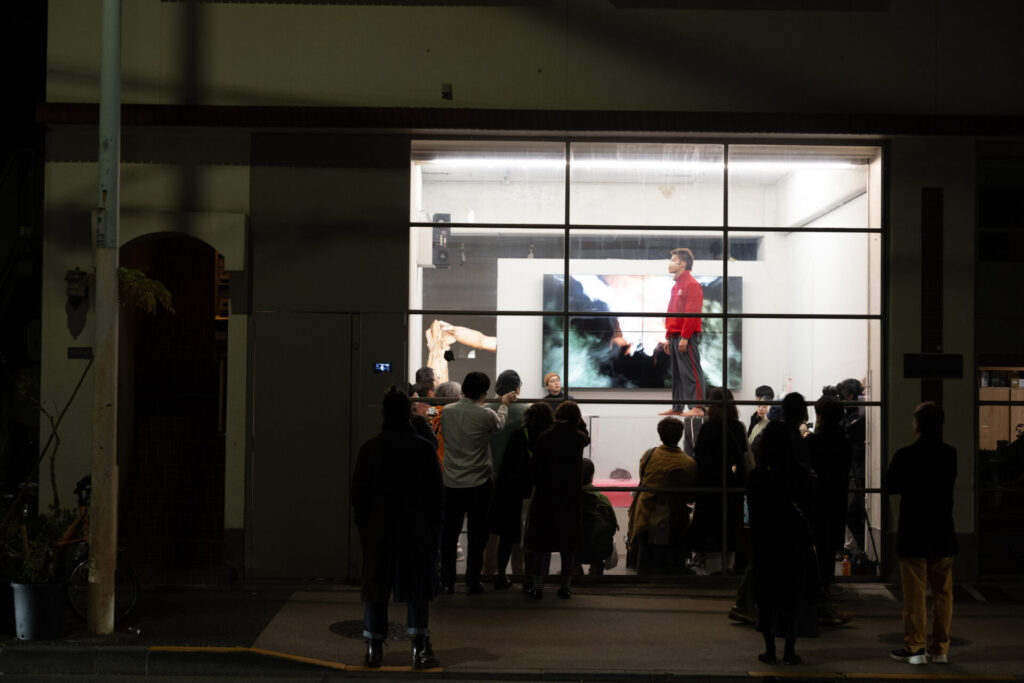
Shota Yamauchi “Apparition”(2023)Performance performer: Karu Miyoshi photo:Koichi Nishiyama
In theology, “transubstantiation” is the word used to describe the conversion of bread and wine into the body and blood of Christ. Duchamp employs this word in a 1957 lecture entitled “Creative Act.” The concept of transubstantiation is the key to understanding Nakao’s curation and Yamauchi’s works. Below, after quoting Duchamp, I will attempt to describe my experience of a virtual transubstantiation.
“Through the change from inert matter into a work of art, an actual transubstantiation has taken place, and the role of the spectator is to determine the weight of the work on the esthetic scale.”
Particles of water released by the humidifier are absorbed by my body, and my body becomes one with these particles. Transformed into water particles, I am eventually absorbed into the liquid that fills the large water tank and circulates through the gallery by means of a tube. Occasionally, behind the wall onto which the footage of “The Dancing Princess” is projected, I am supplied to the ice (= gorilla). Therefore, I am also the gorilla. The skin it has shed is the water that has melted from the surface of the ice, which flows out of the image onto the gallery floor.
This sensation is provided by Eva Hesse’s “Hang Up” (1966), evoked by the tubes that enter and exit the wall of imagery, connecting the world of the artwork with the real world. When the shedding of skin reminds us of snakes, the tubes slithering on the floor begin to look like serpents (whose head and tail are behind the wall of the footage). This sensation resonates with the drawings in “Apparition,” in which a fetus and an adult are transposed, as well as with the rubber suit into which the body in the “The Dancing Princess” poem is twisted.
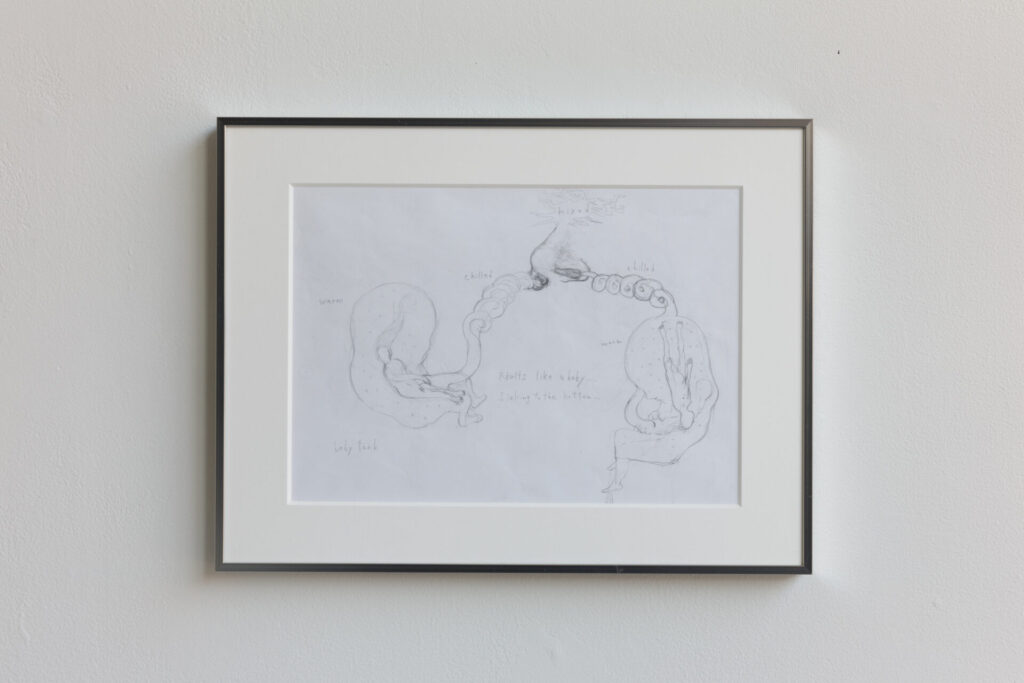
Shota Yamauchi “Apparition”(detail) 2023 photo: Koichi Nishiyama
The view from the outside, through the big glass, leads me to the virtual transubstantiation: my body becomes skin = footage, and my blood turns into water. The shed skin in the “The Dancing Princess” footage turns into water and flows out into the real world. That water, myself, eventually evaporates and drifts throughout the gallery. I, in the form of water particles that are distilled and humidified, and by way of the “Apparition” footage’s resolution and the molecular structure of water, permeate the footage through the monitor’s pixels, becoming involved with the generation of CGI smoke. In video footage, just like in water and air, particle coarseness and density are what make an “image” appear.
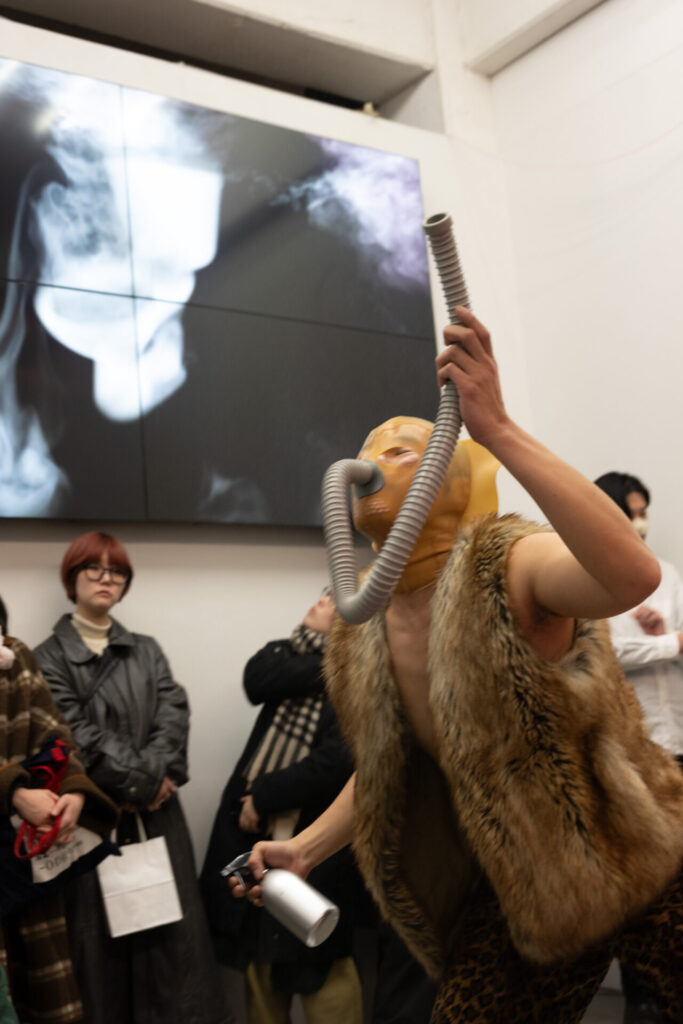
Shota Yamauchi “Apparition”(2023)Performance performer: Karu Miyoshi photo:Koichi Nishiyama
The large glass compresses not only the material and the audience, but even the air inside the gallery, in which smells are dispersed through distillation and humidification. This air is something invisible but perceptible, and an important element in Yamauchi’s work. The compression caused by the glass makes visible even the invisible air and the smells in it; a perverse state, brought about by Nakao’s curation and Yamauchi’s work, and guided by the twin perverse desires of “The Large Glass.” It’s in this perverse state that Nakao and Yamauchi’s efforts to bring about the “apparition” of invisible art come to fruition.
The apparition of invisible art alters the two opening lines of the poem in “The Dancing Princess.” This, the moment when the “illusion” in Yamauchi’s poetry becomes reality, is when transubstantiation occurs, bringing me to my conclusion.
“That night, footage was under the illusion it was water.
Water was under the illusion it was footage.”
Note:
This exhibition is related to “Medium and Dimension: Liminal” (2022), which was also curated by Nakao (see Jun Aoki’s review). The Duchamp quote is from “The Writings Of Marcel Duchamp” (translated into Japanese by Kenji Kitayama, Michitani, 1995).
Translated by Ilmari Saarinen
INFORMATION
Medium and Dimension: Apparition
Dates: 2023.12.1 – 24
Venue: Aoyama|Meguro
Curator: Takuya Nakao
Artist: Shota Yamauchi
Organizer: Medium and Dimension Executive Committee
Cooperation: KYOTO EXPERIMENT
Supported by: 2023 Agency for Cultural Affairs Media Arts Creator Development Support Program


